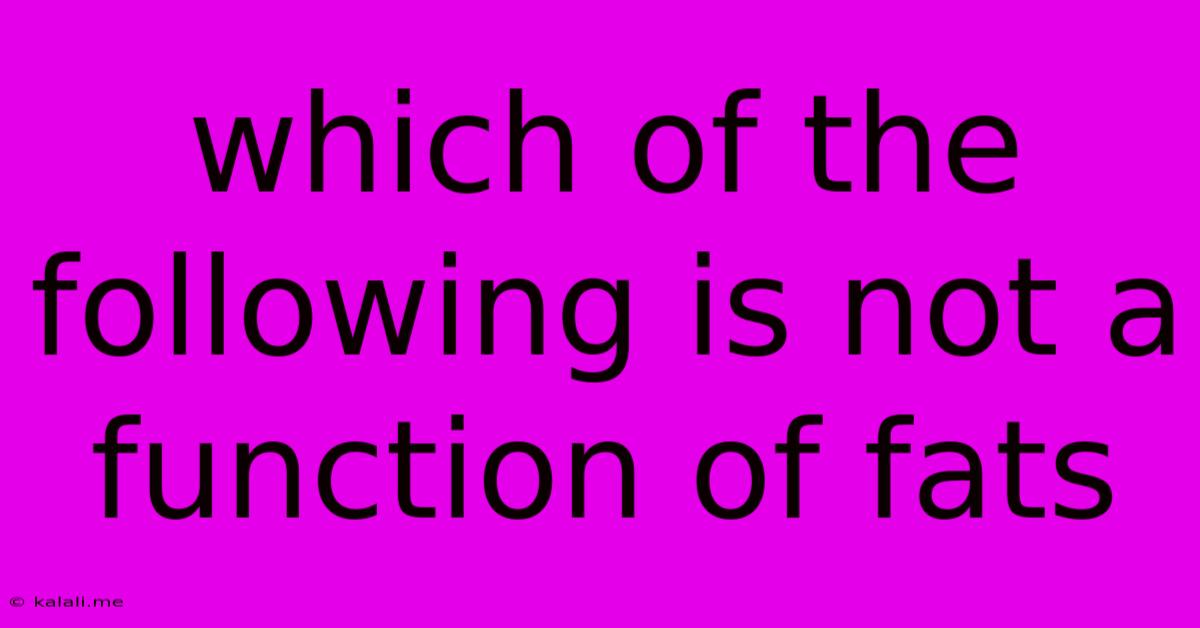Which Of The Following Is Not A Function Of Fats
Kalali
Jun 13, 2025 · 3 min read

Table of Contents
Which of the Following is NOT a Function of Fats? Understanding the Vital Roles of Lipids
Fats, also known as lipids, are often demonized in modern diets, but they play crucial roles in maintaining our health and well-being. Understanding their functions is vital to making informed dietary choices and appreciating their importance. This article will explore the various functions of fats and pinpoint which of the following is not a typical function. We'll clarify common misconceptions and delve into the science behind lipid metabolism.
What are the primary functions of fats?
Lipids are a diverse group of molecules, including triglycerides, phospholipids, sterols, and more. Their functions are equally varied, but generally fall under these key areas:
-
Energy Storage: Fats are the body's most efficient form of energy storage. They provide more than twice the energy per gram compared to carbohydrates or proteins. This stored energy is crucial for long-term energy needs and physical activity. Triglycerides are the primary form of fat stored in adipose tissue.
-
Protection of Organs: Fat pads around vital organs like the kidneys and heart act as cushions, protecting them from impact and injury. This protective function is vital for organ health and overall survival.
-
Insulation: Subcutaneous fat (fat under the skin) acts as insulation, helping regulate body temperature and protecting against cold temperatures. This insulation is particularly important in maintaining core body temperature in cold climates or during periods of exposure.
-
Absorption of Fat-Soluble Vitamins: Fats are essential for the absorption of fat-soluble vitamins (A, D, E, and K). These vitamins are crucial for various bodily functions, including vision, bone health, and blood clotting. Without adequate fat intake, absorption of these vitamins is severely compromised.
-
Hormone Production: Certain fats are precursors for the synthesis of hormones. For example, cholesterol is a precursor for steroid hormones like testosterone and estrogen, which are vital for numerous physiological processes. These hormones regulate growth, development, and reproduction.
-
Cell Membrane Structure: Phospholipids are a key component of cell membranes. They form the lipid bilayer that controls the passage of substances into and out of cells, maintaining cellular integrity. This is fundamental for all cellular processes.
-
Nutrient Transport: Lipoproteins transport fats and cholesterol throughout the bloodstream. These lipoproteins, like LDL and HDL, are crucial for delivering essential nutrients to tissues and removing waste products. The balance of these lipoproteins is important for cardiovascular health.
Which of the following is NOT a function of fats?
Now, let's address the core question. Considering the functions listed above, an example of something that is not a typical function of fats would be: Rapid Energy Production During Intense Exercise.
While fats are a significant energy source, their breakdown and utilization for energy takes longer than the rapid energy release provided by carbohydrates. During intense exercise, the body primarily relies on glucose (from carbohydrates) for immediate energy needs. Fats are a more sustainable energy source for prolonged, less intense activities.
Conclusion:
Fats are essential components of a healthy diet, playing diverse and critical roles in energy storage, protection, insulation, nutrient absorption, hormone production, and cell structure. While often misunderstood, understanding their true functions allows us to appreciate their importance and make informed decisions about our dietary intake. Focusing on healthy fats like those found in avocados, nuts, and olive oil is key to reaping the benefits of these vital nutrients.
Latest Posts
Latest Posts
-
University Of Houston Downtown Gpa Requirements
Jun 14, 2025
-
Which Of The Following Is A Heterotroph
Jun 14, 2025
-
University Of Florida Typical Sat Scores
Jun 14, 2025
-
A Distinct Group Of Organisms Is Called A
Jun 14, 2025
-
What Element Has The Lowest Atomic Mass
Jun 14, 2025
Related Post
Thank you for visiting our website which covers about Which Of The Following Is Not A Function Of Fats . We hope the information provided has been useful to you. Feel free to contact us if you have any questions or need further assistance. See you next time and don't miss to bookmark.